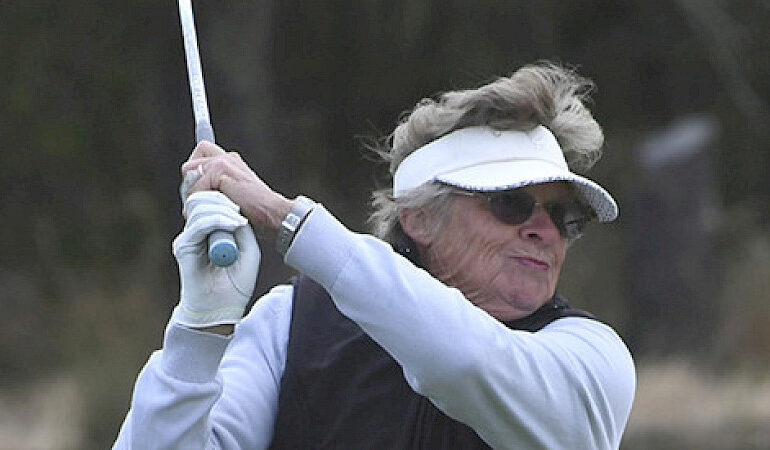Mini Drivers (Compact Golf Clubs) Market Outlook 2025 to 2035
The global mini drivers (compact golf clubs) market is expected to reach USD 897.3 Million by 2035, up from estimated value of USD 630 Million in 2025. During the forecast period 2025 to 2035, the industry is projected to expand at a CAGR of 3.6%.
The mini drivers (compact golf clubs) market is driven by the increasing demand for precision and forgiveness, new lightweight composite materials, and club head technologies which can be adjusted. The growing interest in customized fitting, simulator-based training and portable and travel friendly designs are also accelerating the growth of adoption to meet the needs of both professional and recreational golfers in terms of versatility, control and consistent performance on a wide range of playing conditions.
Quick Stats for Mini Drivers (Compact Golf Clubs) Market
Industry Value (2025): USD 630 Million
Projected Value (2035): USD 897.3 Million
Forecast CAGR (2025 to 2035): 3.6%
Leading Segment (2025): Workability-Focused (Compact Heads) (40% Market Share)
Fastest Growing Country (2025-2035): Japan (3.1% CAGR)
Top Key Players: TaylorMade, Callaway, Titleist, PXG, Cobra, Ping, Srixon, Mizuno, Wilson, Tour Edge, Honma, XXIO, Krank, Thomas Golf, and Sub 70
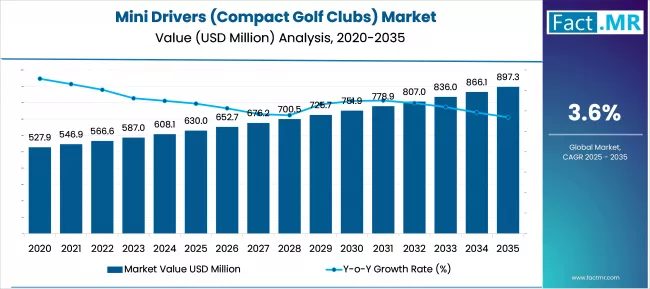
What are the key factors driving growth in the Mini Drivers (Compact Golf Clubs) Market?
The main causes are the choice of golfers to use the clubs that provided them with precision, forgiveness, and versatility. The use of lightweight composite, aerodynamic clubhead design, adjustable clubhead loft and weighting technology can help in improving performance in different course conditions. The growing visibility of club fitting, the advances in the optimization of performance, as well as the benefits of individual customization, is encouraging golfers to pick up mini drivers.
There is also an increase in activity in golf, short-form and recreational golf, and increased technological advancements that lead to a consistent shot and increased range that is increasing demand. The materials and high-quality production are also sustainability-oriented, which also adds to the growth curve of the market.
What are the key trends driving growth in the Mini Drivers (Compact Golf Clubs) market?
The main trends involve sensor-based technology to measure swing analytics, artificial intelligence-enabled club construction, and modular clubheads. Compact drivers that can be taken anywhere are becoming popular because of their portability and due to their versatility. There are forged titanium faces, lightweight composite materials, and aerodynamic additions, which manufacturers are making to enhance control and forgiveness.
Sustainable production and use of materials that are eco-friendly are turning out to be major differentiators. There are also partnerships with professional golfers, simulators and training programs that are creating awareness and adoption. The world is transforming into product development that is driven by technological innovation, customization, and sustainability, and is redefining the mini driver segment.
What factors hinder the growth of the Mini Drivers (Compact Golf Clubs) market?
This is because of high cost of manufacturing advanced material and technology integrated clubs which decrease access by the casual golfers, and difficulty in expansion due to high cost. The niche of compact drivers can be a limiting factor in the adoption of the traditionalists who prefer standard drivers.
Also, it allows new users to be deterred by the frequent product iterations and required special fitting skills. There are additional challenges in competition by other categories of drivers and price sensitive in the emerging markets. There is also a limitation in market penetration due to the lack of awareness among the areas where few people participate in golf and due to the need to continuously educate people about the benefits of having clubs and the importance of fitting.
What are the key regional trends driving the Mini Drivers (Compact Golf Clubs) Market growth?
North America
The North American mini drivers’ market is motivated by the culture of golfing, high level of the development of R&D, and high level of performance-optimized clubs. The opportunity is created by the professional and recreational golfers whose demand is driven by their desire to have personalized, lightweight, and forgiving mini drivers with greater control and consistency in their shots.
East Asia
The market of East Asia is growing owing to increased golfing, precision engineering, and a good brand name. Small, maneuverability-oriented drivers featuring adjustable features and the use of light material are attractive to both amateur and competitive gamers, enabled by simulator golf and short course play.
Western Europe
The mini drivers’ market in Western Europe has the advantage of having a developed golfing society and focus on performance and sustainability. The club designs, lightweight composites and adjustable technology are the factors in this order that encourage adoption, and the environmental consciousness and customization options are the factors that determine buying decisions among the professional and recreational golfers.
Country-wise Outlook
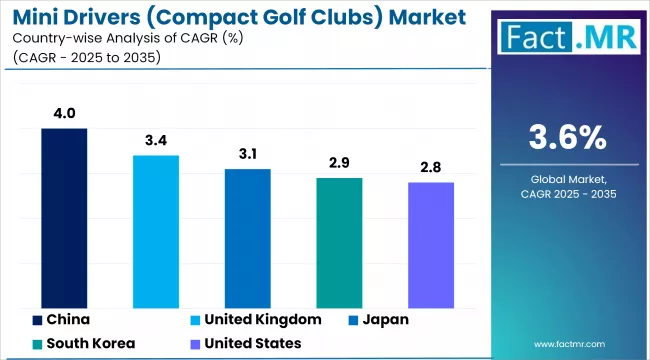
Technological Innovation and Golf Culture Boost the United States’ Mini Drivers Market
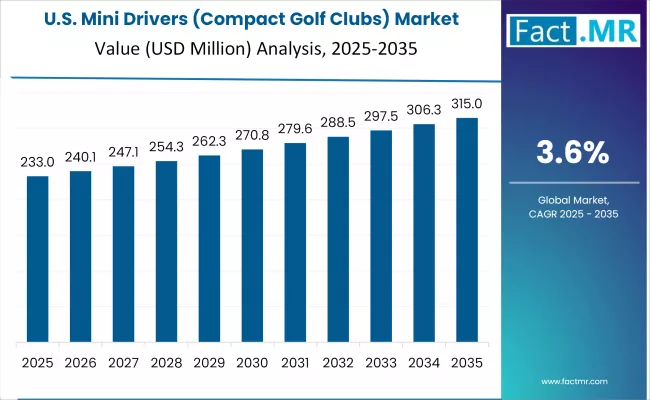
The US mini drivers (compact golf clubs) market is growing at a good rate because of the good R&D, high production and mature golfing culture. Golfers are under demand to acquire high-performance, customizable clubs that have adjustable weighting and lightweight composite materials. Development of aerodynamics, faces, and shafts is being expedited by the combination of club manufacturers and professional golfers together with technology developers. The US has also been one of the major markets in the testing and commercialization of next generation mini drivers that integrate performance, playability and high-quality standards.
Precision Engineering and Consumer Enthusiasm Propel Japan’s Mini Drivers Market
The mini drivers market in Japan is steadily expanding and they have the expertise of precision engineering and a huge number of golf enthusiasts. The manufacturers specialize in small, high-performance models with improvements in control, forgiveness, and shot-shaping. Technologies Advanced material technologies, such as lightweight composites and aerodynamic clubheads, are in the market to serve professional and recreational players. The incorporation of features which can be adjusted and customized solutions are driving adoption, the culture of innovation and brand loyalty of domestic brands within Japan is keeping the country ahead in terms of mini drivers in the Asia-Pacific region.
Technological Advancement and Competitive Play Drive South Korea’s Mini Drivers Market
The mini drivers market in South Korea is growing very fast because of the dynamic golfing market with a tendency to make technological improvements. Compact, workability-oriented drivers having customizable weight systems and high-performance materials are being introduced by local and international brands. The demand is supported by increased interest in simulator golf, short form play, and performance optimization tools. The adoption and positioning of South Korea as an active market in the Asia-Pacific mini driver market is being enhanced by strategic partnerships with club designers and sports academies as well as the development of shaft technology and customizable clubheads.
Category-Wise Market Outlook
Workability-Focused Mini Drivers Lead Product Type Growth
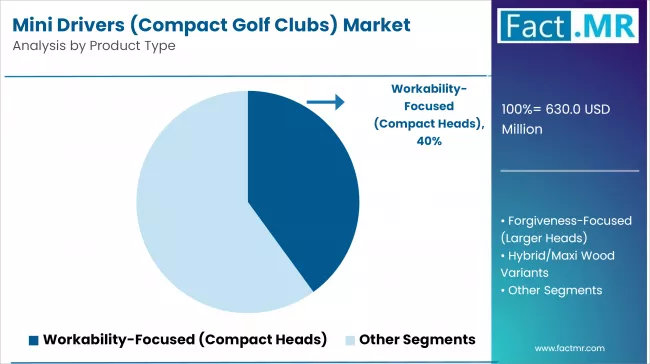
Compact heads with workability properties are the most rapidly expanding among mini drivers thanks to their increased shot-shaping ability and control. Golfers, particularly those who appreciate the ability to control their trajectory and accuracy, find these drivers more acceptable than larger forgiveness-based heads. Small construction is responsive on narrow fairways and unstable lies as well, and thus is suited to a versatile play, with advanced swing skills. Continued enhancements of aerodynamics, face technology and adjustable weighting add more to their popularity among serious amateur and professional golfers.
Mid-Handicap Golfers Drive User Segment Growth
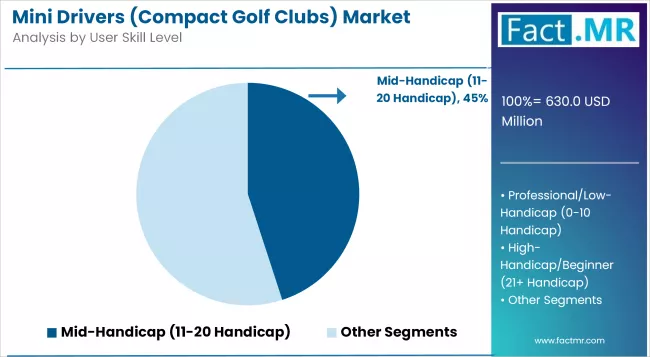
Among the user handicap, mid-handicap players (11-20 handicap) are taking the uptake rate of mini drivers. This group aims to maintain a balance between forgiveness and control, which is why compact drivers are the best choice to enhance consistency without loss of playability. These clubs also receive innovations like variable lofts, lightweight composite shafts, and aerodynamic clubhead design which make these clubs especially appealing to players who are developing their technique and who have a better distance, accuracy and confidence in these clubs in all conditions of the golf course.
Tee Shots Dominate Application Growth
The tee shots are the quickest expanding subcategory of mini drivers. To maximize the launch angle, ball flight, and precision at the tee, golfers are utilizing compact drivers to benefit. It has lightweight materials, adjustable weighting and advanced face technology, which make it easier to play longer and more accurately, and meet the demands of competition play and recreational rounds. The flexibility of tight or high tees also helps with faster adoption, and this usage case is the most important in the mini drivers market.
Competitive Analysis
Competitive Outlook: Mini Drivers (Compact Golf Clubs) Market
The market of the mini drivers (compact golf clubs) is very competitive; its major players like TaylorMade, Callaway, Titleist, PXG, Cobra, Ping, Srixon/Cleveland, Mizuno, Wilson, Tour Edge, Honma, XXIO, Krank, Thomas Golf, and Sub 70 compete with each other based on the advances in research and development, new club designs, and manufactures. These companies have been concerned with lightweight composite materials, adjustable clubhead technologies and aerodynamic improvements to provide a better forgiveness, control and distance. They are able to lead through strong international distribution channels, names, and patented technologies serving the needs of professional and amateur golfers. Their presence on the market is also enhanced with strategic investments in digital club fitting, AI-based performance optimization, and materials that have a stronger focus on sustainability.
More of these incumbents are smaller innovators and new brands who are getting into the market with niche products and services, such as sensor-integrated mini drivers, customizable modular clubheads, and compact travel-friendly designs. Their speed of adaptation to niche segments compensates the size and coverage of market leaders. There is a symbiotic relationship between the traditional brands and the agile brands that develop an innovation-based, strong, and quite competitive Mini Drivers (Compact Golf Clubs) Market.
Key players in the Mini Drivers (Compact Golf Clubs) market are TaylorMade, Callaway, Titleist, PXG, Cobra, Ping, Srixon, Mizuno, Wilson, Tour Edge, Honma, XXIO, Krank, Thomas Golf, Sub 70.
Recent Development
In 2025, Callaway introduced the Elyte Mini Driver, featuring a 340cc clubhead and 43.75″ shaft length. Combining retro-inspired aesthetics with advanced technology, the club delivers versatility for both tee shots and fairway play, offering golfers enhanced control, optimized launch conditions, and consistent performance across varied course environments.
In 2025, leading golf media outlets featured several new mini driver models in their “Best of 2025” rankings, highlighting the growing popularity and innovation within the segment. The inclusion underscores market maturity, increased competition, and the introduction of advanced designs that enhance performance, customization, and playability for diverse golfers.
Fact.MR has provided detailed information about the price points of key manufacturers of Mini Drivers (Compact Golf Clubs) market positioned across regions, sales growth, production capacity, and speculative technological expansion, in the recently published report.
Methodology and Industry Tracking Approach
Over 10,000 participants took part in the Fact.MR 2025 survey on the mini drivers (compact golf clubs) market, with a minimum of 250 representatives of the countries where the surveys were conducted. One-third of the respondents were industry stakeholders such as club designers, material scientists, golf technology developers, regulatory experts, and market consultants, with the other two-thirds being end users (recreational and professional golfers, golf academies, and sporting goods retailers). The survey, which was conducted during the period between September 2024 and August 2025, focused on the trends of the adoption, the trends of customization, performance optimization, and innovations that are influencing the next generation mini drivers.
The analysis used highly sophisticated modeling and predictive analytics, which were backed by more than 250 secondary sources including patent applications, product introductions, industry standards, eco-disclosure, and market reports. The learnings were provided by analyzing trends in player adoption, material and design innovations, and performance-driven by technology and recorded since 2018. In the 2025 report, the stakeholders are empowered with action plan to attract emerging opportunities, solve market problems, and position themselves better in the changing mini drivers (compact golf clubs) market.
Segmentation of Mini Drivers (Compact Golf Clubs) Market Research
By Product Type :
Forgiveness-Focused (Larger Heads)
Workability-Focused (Compact Heads)
Hybrid/Maxi Wood Variants
By User Skill Level :
Professional/Low-Handicap (0-10 Handicap)
Mid-Handicap (11-20 Handicap)
High-Handicap/Beginner (21+ Handicap)
By Application :
Tee Shots
Fairway/Turf Shots
Situational/Backup
By Distribution Channel :
Online Retail
Specialty Golf Stores/Fittings
Direct-to-Consumer (DTC)/Brand Sites
Offline/Pro Shops
By Region :
North America
Latin America
Western Europe
Eastern Europe
East Asia
South Asia & Pacific
Middle East & Africa




